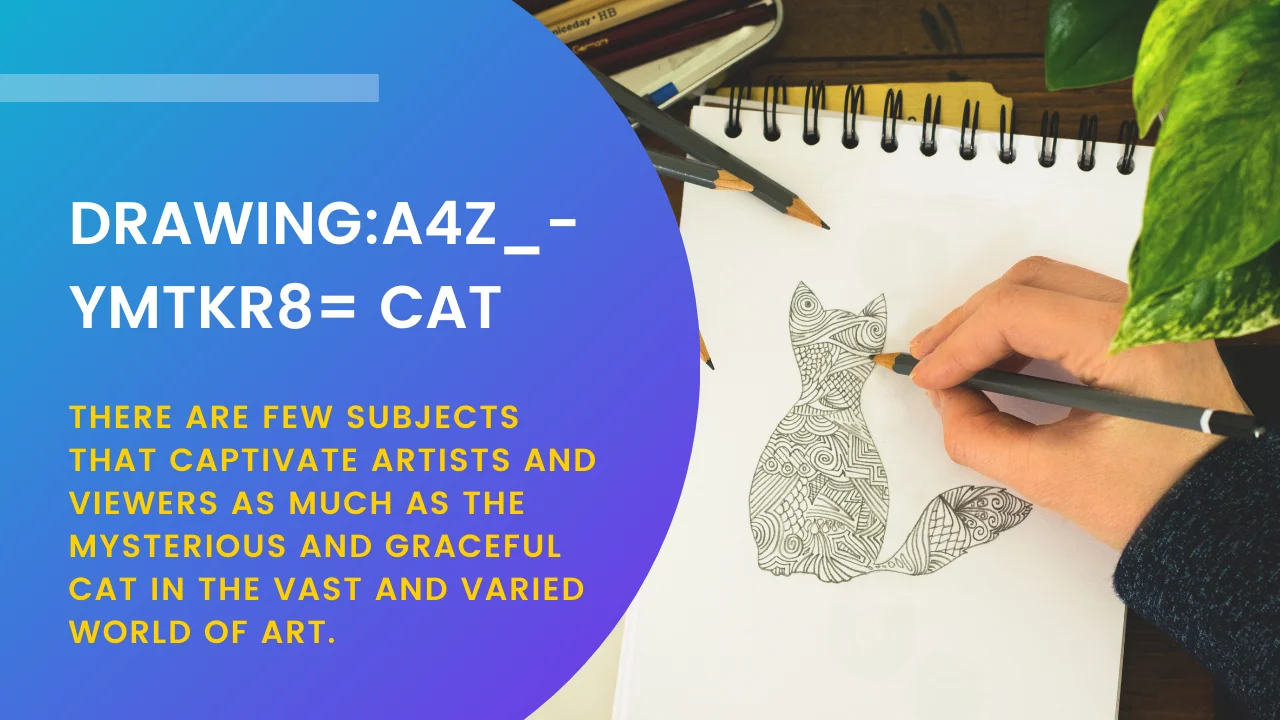Introduction to Cat Drawing
There are few subjects that captivate artists and viewers as much as the mysterious and graceful cat in the vast and varied world of art. Learning to draw cats can give your artistic repertoire a dynamic boost, whether you’re just starting out or are a professional illustrator. Artists of all skill levels will find something useful in this comprehensive guide to Drawing:a4z_-ymtkr8= Cat, as it covers a wide range of techniques and styles.
Understanding the Basics of Feline Anatomy
You need to know the ins and outs of cat anatomy to draw them properly. Important details to keep in mind when drawing these graceful animals are covered in this section.
Key Features of Cat Anatomy
It is essential for any artistic representation of a cat to capture its distinctive physical traits. Every detail contributes to capturing their essence, from their almond-shaped eyes and pointed ears to the graceful curves of their body.
Movement and Posture
Cats can express a wide range of emotions and behaviors just by shifting their body language. Mastering the art of drawing cats in motion—whether they’re leaping, crouching, or stretching—will bring your drawings to life and allow you to capture their spirited nature.
Textures and Fur Patterns
The coats of cats of different breeds are known for their unique patterns and textures. In this section, we’ll go over some methods for drawing Siamese and other short-haired breeds, as well as Persians and other fluffy long-haired breeds, using various pencil strokes and shading techniques.
Eyes and Expressions
The expression on a cat’s face says it all. If you want your drawings of cats to have personality, you must be able to capture the intensity of their gaze. In this section, you will find instructions for drawing the mesmerizing and mysterious eyes of a cat.
Advanced Drawing Techniques for Realistic Cats
You can add depth and realism to your feline drawings by exploring more sophisticated techniques once you’ve mastered the basics.
Shading and Depth
With the right shading techniques, even a flat sketch can be made to look more realistic. To make it look more three-dimensional, you can follow the steps in this section to add highlights and shadows.
Detailing Fur Texture
It is difficult but satisfying to capture the pattern and plush texture of feline fur. Master the technique of drawing fur with fine lines and changing pressures to make it look like the real thing.
Incorporating Color
Color theory can greatly improve your artwork, even though most cat drawings are black and white. Here we’ll go over some tried-and-true methods for picking out and applying color to bring out the subtlety or vivacity of various feline varieties.
Digital Art Tools
This section will go over the software and tools that digital artists can use to make beautiful cat illustrations, including how to set up brushes and apply layers.
Exploring Various Artistic Styles
Countless artistic styles have depicted cats throughout history. From hyper-realistic to abstract, this section invites artists to explore a wide range of styles.
Realistic Style
Learn the ins and outs of drawing cats with a photorealistic style, with an emphasis on getting the details right.
Cartoon and Caricature
Discover the art of cartooning cats—a style often seen in children’s books and animated films—by learning to simplify and exaggerate their features.
Abstract Interpretations
Discover ways to depict cats using abstract shapes and colors, with an emphasis on conveying emotion rather than meticulous realism.
Expressive Cat Sketches
To better depict the grace and spontaneity of a cat’s movements, try drawing them quickly and expressively. Here you will find exercises that will help you become a better motion and emotion conveyer.
Comparison of Different Cat Drawing Styles
| Style | Features | Benefits | Best Used For |
| Realistic | High detail, accurate anatomy, precise shading | Lifelike representations, professional artwork | Advanced artists, realism studies |
| Cartoon | Simplified forms, exaggerated features | Fun, engaging, accessible to beginners | Children’s books, animation, casual art |
| Abstract | Non-literal, uses shapes and colors freely | Expressive, unique personal style | Conceptual art, modern art exhibitions |
| Expressive Sketch | Quick, loose lines, minimal detail | Captures motion and emotion quickly | Practice, warm-ups, capturing live subjects |
| Digital Illustration | Use of software, customizable brushes and layers | Versatile, easy to edit, no physical materials needed | Artists who prefer digital media, commercial work |
Also Read: Instanavigation: Now View Instagram Stories Anonymously
Conclusion
Attempting to draw cats is more than just a creative pursuit; it’s also a quest to learn about these intriguing animals. You will become an expert cat artist with each sketch and line you draw. With the hope that you’ll find a stronger bond between your artistic endeavors and your feline subjects, this guide on Drawing:a4z_-ymtkr8= Cat will provide you with the inspiration and resources you need to tap into your full creative potential.

Karen Altizer is a seasoned professional with a wealth of expertise in marketing and communications, adept at crafting compelling narratives and strategic messages tailored to various stakeholders.

